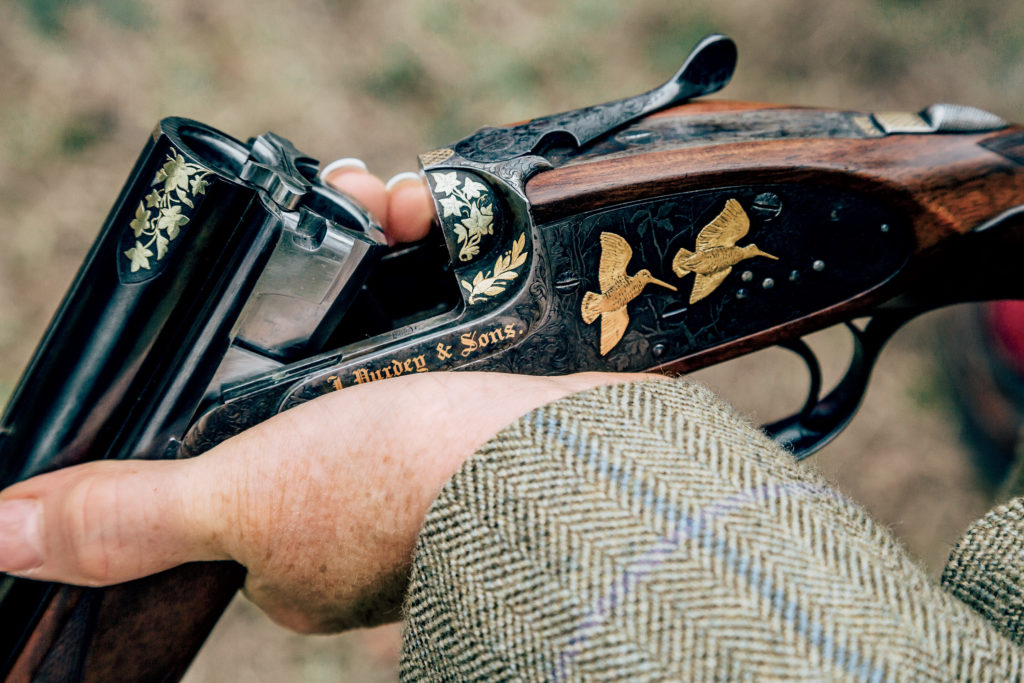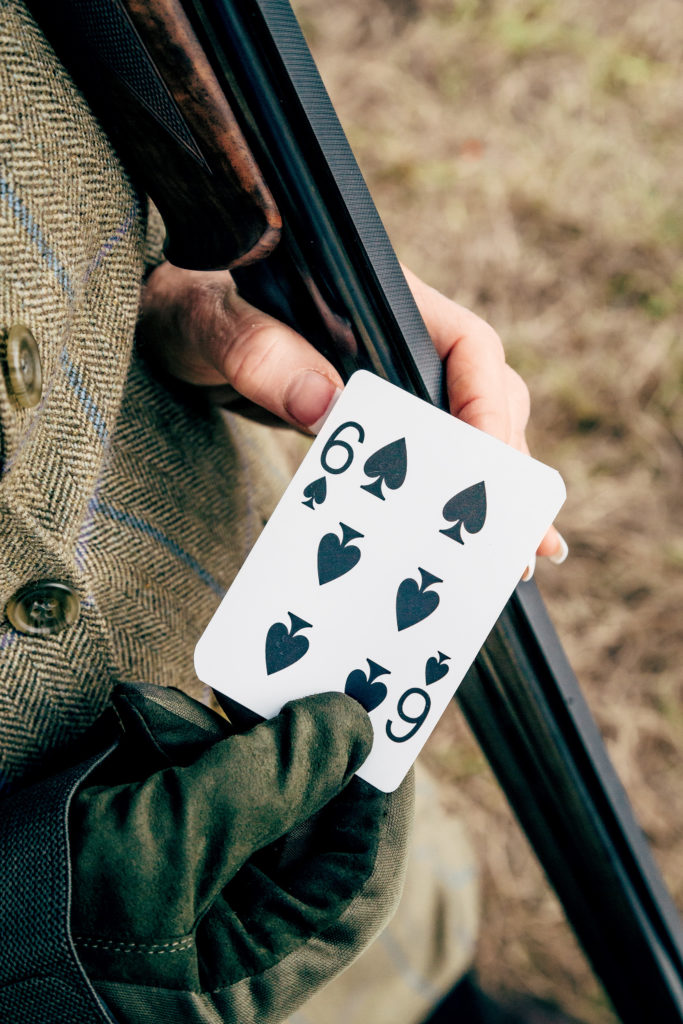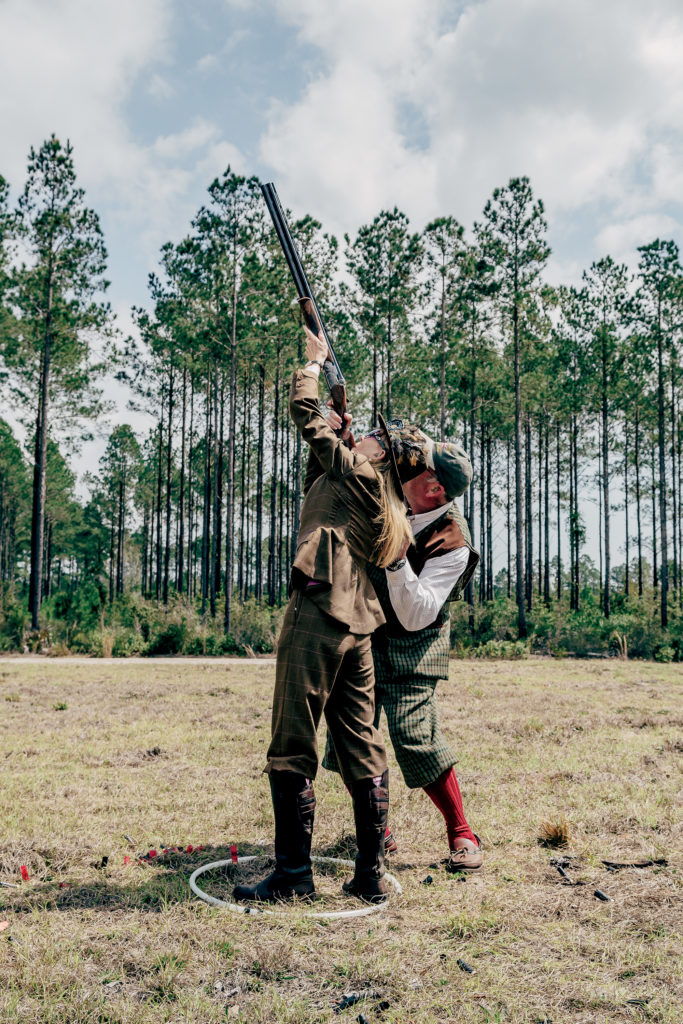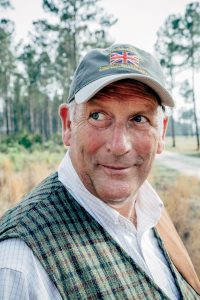Sporting
The South’s Top Gun
If you want to learn the art of British driven shooting––and shotgun shooting in general––there’s no one better to see in the States than Chris Batha. Just don’t let him catch you aiming

Photo: Peter Frank Edwards
Shooting a shotgun accurately is the easiest thing in the world if you remember two things. First, you must never “aim” the gun. You especially shouldn’t look at the bead at the end of the barrel, which was apparently put there to tempt you into using it. Nothing makes you miss so predictably as aiming. Second—to the extent that you do aim, which, as you know, you shouldn’t—it’s paramount that you try to miss the target. Unless you are shooting at empty air, you’ll never hit anything.
After explaining these principles, Chris Batha, acknowledged to be one of the world’s best and most experienced shooting coaches, looks around the table for questions. He’s a big friendly bear of a man who has been in love with shotguns and shooting all his life. He’s usually smiling, as if after thirty years he still can’t quite believe that he gets to shoot and hunt, teach shooting, and mess around generally with shotguns for a living. He seems to have every certification possible for a shotgun instructor—right up to the Olympic level—and is a master gun fitter for E. J. Churchill Guns. He has shot game birds on three continents and in fourteen countries. He shot competitively—and successfully—for years and still does when he has the time, which is never. He represents a number of fine gun companies and owns one himself, Charles Boswell Gunmaker. He designs sporting clay courses and is a noted authority on fine guns. He is one of seven people in the world who have qualified at all three levels of the British City and Guilds program. If it involves a shotgun, Batha is your man.
At twelve he was already shooting birds and selling them to local butchers. At fifteen he joined the Merchant Navy. He became a London firefighter, which required that he be able to carry someone of his own weight across his shoulders. Only a small percentage of such candidates were accepted into the London Fire Brigade. He became a London taxi driver, the exam for which is regarded as the world’s single most difficult geography test, entailing the memorization of twenty-five thousand streets and twenty thousand landmarks. He studied catering and once owned two pubs. He was shooting competitively, instructing, and hunting at the same time. He considers one of his highest accolades that he is a member of the Worshipful Company of Gunmakers—a great title for a prayer breakfast—which was founded by Royal Charter in 1637.
And, yes, I actually do have a question for Chris Batha. I’d like to know which brand of dog food he’s been smoking. But I don’t ask because none of the seven students in his two-day British Driven Game Shooting Academy look at all perplexed. It’s clear both that they have heard this before and that they take it as gospel. I can’t decide whether I’m nuts or simply out of my depth. The class is at the Dorchester Shooting Preserve outside of Savannah, and students have come from as far away as Colorado and Wisconsin. Some have hunted previously in the U.K. and just want to brush up on their shooting skills. Others want to learn the vocabulary and the right fork to pick up if they ever do go. There’s a lady in smart tweeds and what are evidently the right kind of purple socks, which have tassels at the top, and a feathered hat to match. She has brought a number of guns in cases made of animal hides that still have the hair on them and undoubtedly cost more than my Remington 11-87, which I had the sense to leave home. Her bespoke Purdey 20-gauge, I was discreetly told, cost between $85,000 and $100,000. A number of these folks have already signed up for four days of shooting with Batha in Scotland in November (at $13,864 plus airfare, it’s on the low end of such hunts). I’m here for two reasons. One is to get a jump on the lifestyle I intend to bear-hug after I win the lottery. And while I have shot poorly for so long that improvement seems unlikely, I would like to miss with a bit more style.

Photo: Peter Frank Edwards
Precious Metal
A bespoke James Purdey & Sons 20-gauge over-and-under, engraved by Ken Hunt.
Right, then, Batha says, moving on to the finer points of shooting. The way you mount the gun to your shoulder and eye is everything. You want it to be automatic, so deeply grooved in the brain that it becomes instinctive. This is a simple matter of practicing the mount ten thousand times before a mirror, your gun empty, your eye focused on itself in the glass. He makes this sound like a minor detail, easily accomplished in just over three months. “You do five repetitions of ten mounts in the morning, five reps of ten in the evening, and then you’ve got it.” Onward. The moment you see the bird (clay or feathered), you point at it with your leading hand (the one holding the forend, the wooden grip below the barrel) and track its line of flight with the leading hand and muzzle. Many people grip with the index finger pointing straight down the forend so that you really are pointing at the bird. As you track its line of flight, you bring the gun up and into your shoulder so that your cheek presses into the comb (the top edge of the stock) and your eye aligns with the barrel. Which you never look at, of course. You’re accelerating the speed of your swing as you do all this. As the gun touches shoulder and cheek, you accelerate the swing even more so that the gun moves ahead of the bird. You want to fire into empty space ahead of it. “They do not fly backwards!” Batha says. You pull the trigger and continue the swing through the shot, just as you would with a golf club or a tennis racket. And, depending on the composition of the bird, you have just transformed it into a little cloud of black dust or an inert feathered object even now plummeting from the sky.
And not for an instant have you either aimed your shotgun or shot it at the bird itself.
We will be not aiming and intentionally missing a lot very soon. At which point I’ll confirm both that I’m by far the worst shot in the group and that the cocktail of pleasurable neurotransmitters released when you do happen to make a shot is so pleasurable as to be addictive.
First, however, a bit of history. The French nobility of the seventeenth century were evidently the first to shoot birds on the wing for sport, walking in step with a line of “beaters” to drive the birds into flight. In 1660, when Charles II returned from France after his unfortunate exile (which we shan’t discuss here), he ignited a passion for the sport in England. It was soon found to be more effective to have the line of beaters driving birds toward a line of hunters, or “guns,” as they are called. Further, a line of pickers-up positioned forty yards or so behind the guns was a handy thing, saving you from finding and retrieving the birds yourself.
In the mid-nineteenth century, the English gentry had a great deal of money and very little to do. Wing shooting—which required considerable outlays of cash, time, and work, done by other people, naturally—was the ideal outlet. The upper class became passionate and competitive devotees of the sport. They competed to see which estate could shoot the most birds, the tally being published in London newspapers. They competed to see who could acquire the best grouse moors, which was a particular coup (pheasant and partridge can be raised in captivity, grouse can’t). As tweed clothing became popular, estate owners went to great lengths to commission “estate” tweeds, patterns unique to a given property. Many aristocrats did little but hunt, becoming, in effect, professional shots. Their insistence on the best quality guns drove the development of the modern shotgun, which needed to handle the hundreds or thousands of cartridges shot over a day’s hunt without malfunction.
It took a few seconds to load any gun after it had fired its two shots, so the hunter who went afield with three shotguns and two loaders—and rotated guns continuously—could shoot without ever taking his eyes off the sky. Lord Ripon, the Earl de Grey, was a particularly keen hunter and considered one of the best shots of his era. Over his lifetime, he recorded taking 552,813 furred and feathered game. He dropped dead on the grouse moor after a successful day’s hunt in 1923. A photo from the period shows him with his loaders and guns as he shoots directly overhead. You can’t see much of the earl’s face except the underside of his chin. Even while downing birds at a furious pace, he was relaxed enough to have a pipe between his teeth. He once shot twenty-eight pheasant in sixty seconds as a guest on the Sandringham House estate.
Driven shooting is nearly the opposite of American “shoe leather” hunting. We generally “walk up” birds behind dogs, which then point and flush them from cover, offering low and straightaway shots. The classic setup in driven game shooting—especially with pheasant and partridge—has beaters driving the birds from one hilltop to another, with the line of guns positioned in the valley between. These days, Batha tells us, “the true sportsman is measured by the difficulty of the shots he makes, not the number of birds killed.” A sportsman allows low, easily shot birds to pass, opting instead for the more challenging high birds. Since these birds may be 150 feet up, they are best shot when nearest, just as they pass overhead. What you want to be doing, Batha tells us, is acquiring the bird at ten o’clock and shooting in front of it at eleven thirty or so. “You make a good shot on a difficult bird,” he says, “and you fall asleep reliving it, thinking, Gosh, I really did something there.” It’s obvious that to Batha, there’s nothing on earth that compares with this feeling.
The enormous manpower involved is what makes driven game shooting so spendy. “It’s like putting on a play,” Batha says. “All the audience sees are the actors, but it takes a host of people backstage to pull the thing off.” In addition to the beaters, pickers-up, and loaders, there are flankers, also known as flaggers, positioned to discourage birds from sneaking out the sides of the advancing line of beaters. The gamekeeper manages the estate’s operation, from selecting cover crops to raising birds to discouraging poachers. There are guides, who know the land, the birds, and how to fix a gun.
Before the hunt, each gun draws a numbered “peg” to establish his or her position in the line. The pegs may be actual ivory or

Photo: Peter Frank Edwards
Cards are drawn to establish a shooter’s position.
steel pegs or playing cards. A line of guns usually includes up to ten people, spaced between ten yards and forty yards apart, depending on terrain. Often the pegs at the ends have the most action, which is why pegs are rotated two or more spaces between drives. “There will be drives when you might be almost a spectator,” Batha tells us. “And others when you can’t believe the number of birds flying over.” No matter the circumstances, it’s bad form to shoot birds that are flying over your neighbor’s head. When someone does this to you, it’s called “taking a bird off your barrel.” If, however, your neighbor has fired both barrels and missed, you may attempt to “wipe your eye” with a follow-up shot. It’s considered very bad form to shoot others, whether a neighboring gun, beater, or picker-up. For this reason you want to establish safe “arcs of fire” and never take a shot less than forty-five degrees up. “The only safe bird to shoot is one that has blue sky all around it,” Batha tells us. Although he confides that he has seen men squat down in order to get a blue-sky shot. Also bad form.
After a light lunch, we take golf carts to an open field. Sixty yards away and forty-five feet up a rented cherry picker are machines that zing out orange clays in all directions, all of which are up. We’ve broken into two groups. I’m in the one overseen by Batha’s assistant for the class, Elizabeth Lanier, a charming top-tier shooting instructor from Richmond, Virginia, and the founder of GRITS—Girls Really Into Shooting—an organization that encourages women’s participation in the shotgun sports. I’m doing my best not to aim and to miss each bird, and damned if I’m not succeeding at it as bird after bird floats unbroken to the ground. On the other hand, I’ve got a nice rhythm going: swing, mount, miss. “You’re behind it,” a voice says. It’s Lanier, standing eighteen inches behind me. “And right. Try shutting your left eye when you shoot.” I tell her I’m already shutting my left eye, which is what my last shooting instructor advised. She shrugs. “So try shutting it earlier, while you’re bringing your gun up to your eye.”
I try this and turn the next bird to black dust, which bathes my brain in the wonderful chemicals. “That’s it!” Lanier exclaims and actually does a little shimmy. “Do it again.” I do. Twice.
“Oh yeah! Flight canceled!” she crows, actually hopping from one foot to another. She’s not faking it. She gets genuinely excited when a student succeeds. I do another, transforming this one into a particularly fine dust cloud. “We call that Alabama talcum powder!” she says. “You’re nailing them!”

Photo: Peter Frank Edwards
High shots are the norm in driven shooting, often almost overhead.
This kind of success is evidently more than I can take, so I start to miss again. “You’re cocking your head,” she says. “Think about keeping your eyes level the whole time.” This is a new concept. The clays start dusting again. Then they don’t.
“You’re losing your lead,” Lanier says. “Pretend you’re holding a garden hose and spraying the target.” This is a concept I can grasp. I start breaking them again. Lanier crows again. The woman is amazing. You can’t fake this kind of excitement. You’d die of exhaustion in a couple of hours. I break six of the next eight with my garden hose. It feels fantastic.
I overhear Batha instructing a student in the other group, a trim fellow and excellent shot with his Perazzi, which has long barrels, thirty-four inches, often favored by trapshooters. But even he misses occasionally. “You’re trying to be too precise,” Batha says. “You’re shooting a rifle. What do you do for a living?”
“I’m a surgeon,” the man says.
“Well, there’s your trouble right there, innit?” Batha says. “It needs to be quick—touch and go. You’re staying in the gun too long. You’re starting to think. And then you’re done.”
Batha strolls over to watch me. “You’re shooting well now, but then you do this weird Magic Johnson flourish with your barrels at the end. So then you’re not ready for the next shot, are you?” I’ve been told I sometimes fail to swing through the shot, so I’ve been trying to do that. But Magic Johnson flourish? Where did that come from? “Yeah,” Batha says, finger scribing an elaborate squiggle in the air. (Does Magic Johnson decorate cakes?) Not sure how Magic got here, but I resolve to stop doing his flourish.
Next Batha has us work as two-person teams, a gun and a loader. Fine shotguns are all double-barreled guns, and opening the action ejects the two spent shells, which you replace with two new cartridges. The instant the gun fires his second shot, he opens the action. The loader quickly inserts the cartridges and calls “Close,” the moment his hands are clear. This allows the shooter to keep his eyes skyward, and he may be swinging on a bird he sighted while you were loading the moment he hears “Close.” I’m surprised at how much I enjoy being a loader. It’s a skill. “Oh, a good loader is worth his weight in gold,” I remember Batha saying earlier. The task rewards dexterity and focus. It’s like being a one-man pit crew.
To end the class, Batha announces that each group will get a few “hundred-bird flurries,” a bunch of birds coming in large groups at unpredictable intervals. It’s a scenario you’d never see in American sporting clays, where the maximum number of birds in the air at any one time is two. And it’s where I do my best shooting of the whole course. There are so many birds zipping by that I don’t have time to think. I’m just reacting, reaching out at bird after bird, pointing the gun out and up, swinging and shooting. For a time I’m unaware of anything else, completely lost in the moment, dusting birds left and right. It’s bliss. And then the machines are done, out of birds.
“Excellent!” Batha says, clapping me on the shoulder. “I’d hardly guess that you’re a writer.”
Back at the lodge over a cocktail, I find myself talking to Jim, a farm boy turned lawyer in Midland, Texas, who has already signed up for the November trip. “I’m not the world’s most live-on-the-edge guy, but I’ve really enjoyed this,” he says. “I know that in one sense it’s kind of ridiculous, kind of extravagant. But I grew up in cotton fields and now I’m gonna be shooting birds near a castle in Scotland.” He isn’t even trying to disguise a happy, what-the-hell smile. It’s clear that he can’t wait for November.








